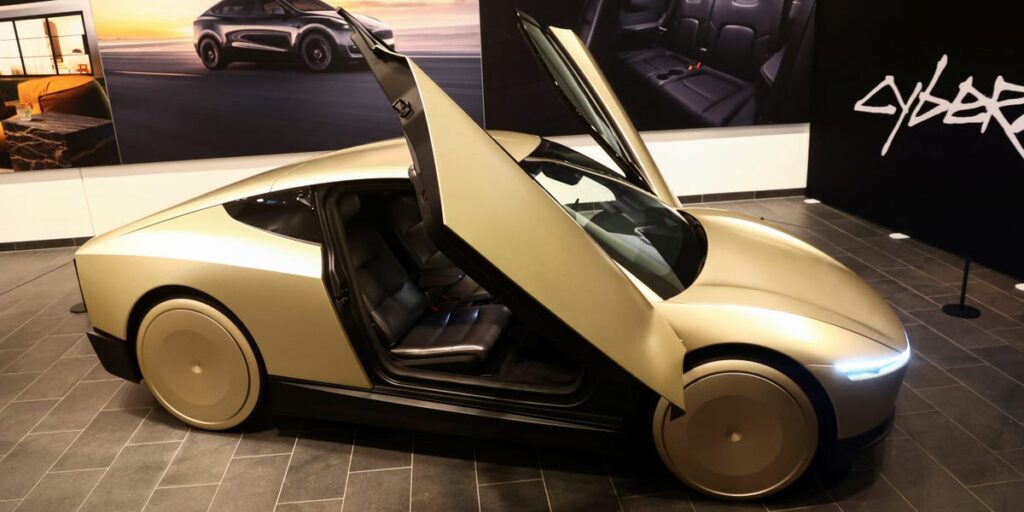Tesla provided more details about its planned June robotaxi launch in Austin during Tuesday’s Q1 earnings call.
A robotaxi service from Tesla comes years after several missed deadlines and an increasingly competitive — but smaller — field.
General Motors’s Cruise bowed out of the race earlier this year, but Alphabet’s Waymo has continuously ramped up its service and is now providing 200,000 rides a week in limited parts of the San Francisco Bay Area, Phoenix, Atlanta, and Austin, according to the company.
There’s also Amazon’s Zoox, which makes its own purpose-built robotaxi, and other software-focused companies that hope to provide autonomous driving features to OEM vehicles.
But Elon Musk swears by the company’s approach to autonomy.
During the earnings call, he described Tesla’s self-driving capabilities as a “generalized solution using artificial intelligence.”
The CEO has touted this approach before, which refers to Tesla’s reliance on cameras — as opposed to a pricy hardware stack made up of sensors and cameras — and an AI that will use the visual input to drive the vehicle. This could allow for Tesla to scale autonomy quicker and at lower costs since, in theory, any Tesla model could be deployed as a robotaxi.
“I predict there will be millions of Teslas operating autonomously — fully autonomously — in the second half of next year,” Musk said during the call.
Here’s what we now know about Tesla’s robotaxi service — and some lingering questions:
What will Tesla’s planned robotaxi rollout look like in June?
Tesla was careful to call the robotaxi service we’ll see in June a “pilot” rollout, which hints at the limited scale of the initial launch.
Musk said during the call that “day one” of the robotaxi service will start out with “maybe 10 or 20 vehicles.” From there, Tesla will “scale it up rapidly,” he said.
“Once we make it work in a few cities, we can basically make it work in all cities in that legal jurisdiction,” he said.
Which Tesla cars will be used for the robotaxi launch?
The first set of Tesla robotaxis is expected to be Model Ys through a software update, according to Musk.
“With the software update, it will become autonomous,” Musk said. “To be clear, the Model Ys that we’re talking about being autonomous in Austin in June are the Model Ys we make currently. There’s no change to it.”
It’s unclear if the first batch of robotaxis will be managed directly by Tesla or if it will consist of privately owned Teslas through which owners will opt in to the service.
The CEO also clarified that the Cybercab is a separate product. In October 2024, Tesla unveiled a purpose-built, two-door robotaxi with no steering wheel.
“We’ve got a product called the Cybercab,” he said during the Tuesday earnings call. “And then if any Tesla — which could be a (model) S, 3, X, or Y that is autonomous — is a robotic taxi or robotaxi. It’s very confusing.”
So, when will we get the Cybercab?
Volume production of Cybercab is still on schedule for 2026, Lars Moravy, Tesla’s vice president of vehicle engineering, said during the call.
Moravy said that the company is currently at the “B-sample validation” of the vehicle, which means Tesla is building the prototype of the car but using material that will be close to the final product.
“Big builds” or the next stage of vehicle-building before volume production is coming at the end of the second quarter, Moravy said.
Tesla anticipates that it will be able to pump out Cybercabs quickly at scale by using what the company calls its “unboxed” method of manufacturing.
Traditional car manufacturers build cars on an assembly line. Tesla is betting on a new method where different parts of the car are simultaneously assembled and then later combined.
“We’re still on schedule for production next year,” Moravy said.
How can we order a Tesla robotaxi in June?
Tesla didn’t address how people in Austin will be able to order a robotaxi at launch during the earnings call.
The company has previously teased its ride-hailing mobile app last year, in which a user can “summon” a car and adjust the climate settings before it arrives.
When will Tesla robotaxis be available outside Austin?
Musk didn’t provide an exact timeline for Tesla’s expansion plans. But the CEO gave some pretty ambitious numbers.
On top of predicting “millions” of robotaxis on the road by the second half of next year, Musk said he predicts Tesla will take “90-something percent” of the rideshare market.
Musk is so bullish on these numbers because, in theory, any Tesla on the road should be able to function as a robotaxi through a software update.
This is different from a company like Waymo, which not only relies on sensors and cameras for its autonomous vehicle but also needs to map out a city before its robotaxis can be deployed to the public.
A Waymo spokesperson did not respond to a request for comment.
Read the full article here


